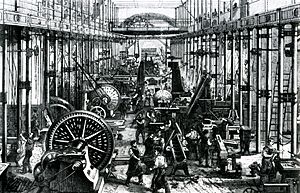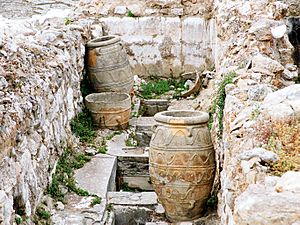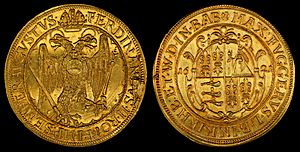Economy facts for kids

An economy is how a country or group of people manages its money, resources, and trade. It's about how things are made, bought, and sold to meet everyone's needs and wants.
Two important parts of an economy are goods and services. Goods are physical items you can buy, like cars, food, or clothes. Services are actions that one person pays another to do for them. This includes things like medical care, teaching, or babysitting.
The study of economy, called economics, is split into two main parts: macroeconomics and microeconomics.
Microeconomics looks at the small parts of the economy. It studies why someone buys one product over another, how the supply and demand of products work, what price a company charges, and why different jobs pay different amounts of money.
Macroeconomics looks at the economy as a whole. It studies things like a country's total economic output (like its Gross National Product), how many people are unemployed, how much a country imports and exports, and the rate of inflation (when prices go up).
Contents
Types of Economies
There are different ways countries can organize their economies.
Traditional Economy
A traditional economy is usually based on bartering (trading goods directly), trading, and farming. This type of economy often follows old customs and traditions. People in traditional economies often do the same jobs as their parents or grandparents. There is little change in how things are done.
Market Economy
A market economy, sometimes called a "free market," is based on supply and demand. In this system, people are free to buy whatever products they want. Companies can make whatever products they want. There is very little government involvement. The idea is that competition among businesses helps the economy work itself out.
Command Economy
In a command economy, the government has strong control over the economy. The government decides what goods are made, what price they will be sold for, and who gets the profits. The government often owns many of the major industries in the country.
Mixed Economy
A mixed economy combines parts of both a market and a command economy. In this system, some industries are owned and controlled by the government. Other industries are left to the market, meaning supply and demand decide what happens. Mixed economies can vary a lot in how much control and regulation the government has.
How Economies Develop
Economies have changed a lot throughout history.
Ancient Economies
In ancient times, economies were mostly based on subsistence farming. This means people grew just enough food to feed themselves and their families.
Industrial Revolution Phase
The Industrial Revolution brought big changes. Farming became more organized and larger scale. Economic growth happened mostly in mining, construction, and manufacturing. Commerce (buying and selling) became more important as people needed to exchange and distribute goods.
Modern Consumer Societies
In modern economies, services, finance, and technology (the knowledge economy) play a much bigger role.
Economists often describe modern economies using a "three-sector model":
- Primary stage of the economy: This involves getting raw materials from nature. Examples include farming (like growing corn), mining coal, cutting wood, and getting iron. A coal miner or a fisherman works in this stage.
- Secondary stage of the economy: This is about turning raw materials into finished goods. For example, making steel into cars, or textiles into clothing. A builder or a dressmaker works in this stage.
- Tertiary stage of the economy: This involves providing services to people and businesses. Examples include baby-sitting, showing movies at a cinema, and banking. A shopkeeper or an accountant works in this stage.
- Quaternary stage of the economy: This stage involves research and development. It's about finding new ways to use natural resources or create new products. For example, a logging company might research how to use burnt wood for paper. Education is sometimes included in this sector.
Other important parts of a developed economy include:
- The Public Sector (or state sector): This includes government services like parliaments, courts, emergency services, public health, schools, libraries, and national parks.
- The Private Sector: This includes businesses that are privately owned and run for profit.
- The Social sector (or Voluntary sector): This includes charities and non-profit organizations that help the community.
Measuring an Economy
There are many ways to measure how well a nation's economy is doing. These include:
- Consumer spending: How much money people are spending.
- Exchange rate: How much one country's money is worth compared to another's.
- Gross domestic product (GDP): The total value of all goods and services made in a country in a year.
- GDP per capita: The GDP divided by the number of people, showing the average per person.
- GNP (Gross National Product): Similar to GDP, but includes income from citizens and businesses abroad.
- Stock Market: Where shares of companies are bought and sold.
- Interest rate: The cost of borrowing money.
- Government debt: How much money the government owes.
- Rate of Inflation: How quickly prices for goods and services are rising.
- Unemployment: The percentage of people who want to work but cannot find a job.
- Balance of Trade: The difference between a country's total exports and total imports.
Related pages
Images for kids
-
Frankfurt Stock Exchange in 2015.
See also
 In Spanish: Economía para niños
In Spanish: Economía para niños






